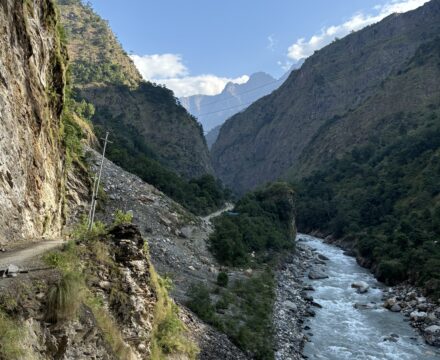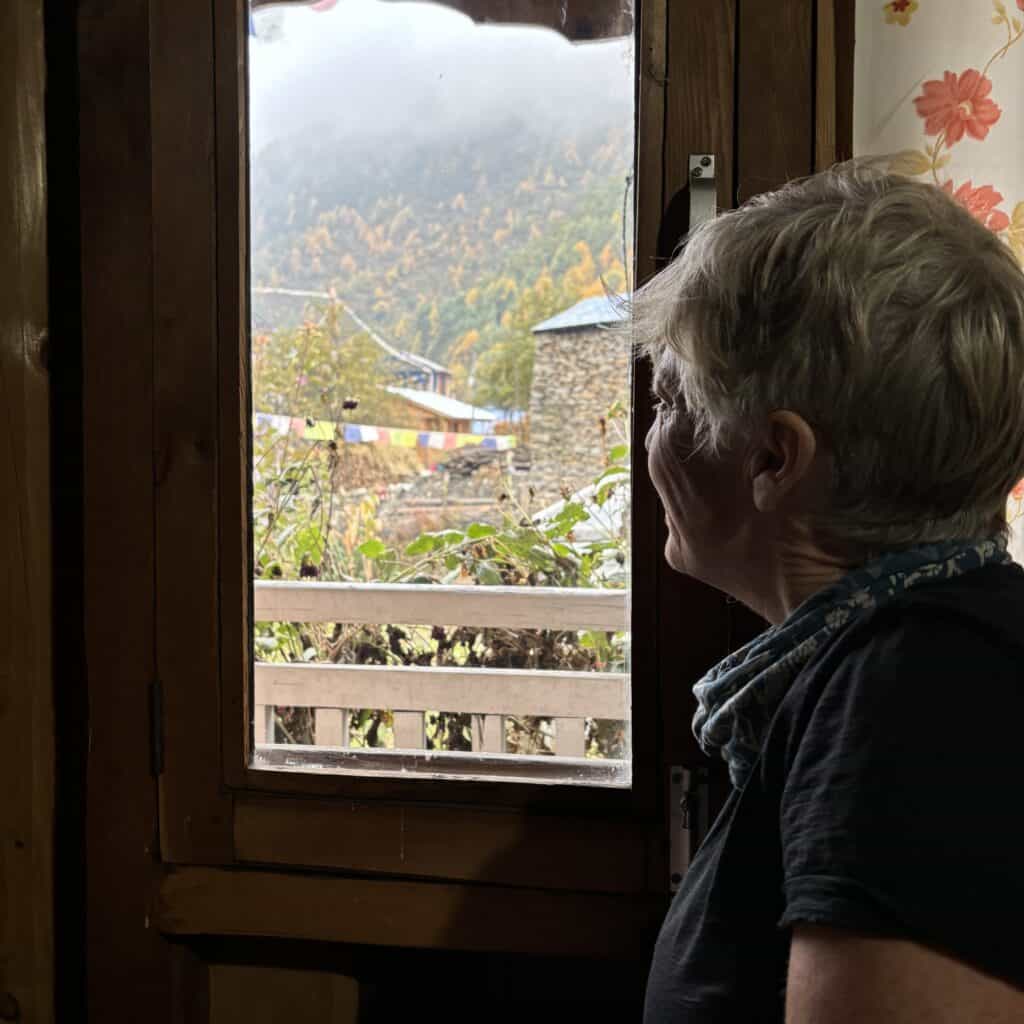A trek above sea level
As a follow up to the article on the similarities of the trekking and expedition company Jagged Globe and Classic Sailing. I thought I would tell you the story of climbing to 5106 meters in the Himalayas.
Kathmandu, capital and largest city of Nepal, is a rabbit warren of streets full of people, bicycles, motor bikes and cars. The traffic flows but the controls are all human. The speed is slow and only major intersections have policemen suggesting who goes where. It’s all done by courtesy, you pull out in a car to cross the traffic and the other vehicles stop and let you do it. There are occasional bits of string between traffic cones in the middle of the road to stop a right turn at a junction, (They drive as we do on the left, some relic of our colonial past.). It looks chaotic but it works. Saves hugely on traffic signs, roundabouts and all that stuff.
After a day of trains and overnight flights it was good to have night in a smart hotel with a nice courtyard garden.
Next morning 9 trekkers were joined by 3 guides and 5 Sherpas, actually the guides and Sherpars were all technically Sherpas as they all came from the same village near Mount Everest and we got into a minibus to head to the Himalayas. The level of excitement was high.
A long hot bumpy ride and with stops in Teahouses for refreshments. I loved the fact that if you were approaching someone and said the magic word Namaste while putting your hands in prayerful position with a slight bow you got a lovely similar response and a nice smile. I could n’t speak the language but the smiles brightened both our days.






First Teahouse stop was in a Teahouse at Sati Khola. Here and every night we were walking we stayed in residential Teahouses, the accommodation and facilities standards varied greatly but the food was consistently good local food in ample quantity. Our bedroom was by the roaring river Buri Gandaki which we followed for the next 10 days finally climbing above its source. In our bedroom we were lucky to have a basic western toilet and shower ensuite but this did not happen every night.
Sherpas
During our first supper together I was talking to the guides and one of the Sherpas. Chhiring the head guide introduced me to Sonam one the Sherpas that carried our main baggage. Sonam was named after a glacier and in his youth suffered damage to his ears. If you phone me you will quickly discover that I’m quite deaf and it helps if I have my hearing aids switched on. There we were both talking in ninety to the dozen in different languages and not hearing what we were saying, but we hit it off.
Sonam was the fastest of the Sherpas and he always seemed to have the biggest load. Each Sherpa carried two persons’ baggage plus their own stuff and they always raced ahead of us with Sonam in the lead.
After supper a group of young people and some elders sang and danced traditionally outside which was fascinating to see.
The first day of walking and I was over anxious to prove myself, so I set off at a great pace trying to keep in the lead. Practicing with walking poles, sunglasses and sunscreen, none of which I normally use. It was hot and humid and the sunscreen dropped into my eyes and then got smeared on the sunglasses. I overstretched myself and my legs felt horrible. I feared I might not be up to it, but I was not alone in that worry.
We walked all day on a road that had the occasional passing pick up truck. It was dusty but gave great views down into the gorge that we rose past on the track.
As we approached our teahouse for the night dusk was settling as we entered the village we named it the ‘Three Horse Town’ as they were about all we could see. Actually it is called Jagat and the accommodation overlooked the tiny village square.
Leaving Jaget in the morning we passed our first mani wall. Mani walls have flat stones, inscribed with the mantra “om mani padme hum” (“hail to the jewel in the lotus”). They are found near Himalayan villages, monasteries, and trails. We were asked to pass them on the left, following a clockwise path, in keeping with Buddhist tradition. If they had prayer wheels in them I tended to set them spinning, it just felt the right thing to do.
Steps to far
The agony of the first day’s walking was a big concern for me and I was wondering how I would be able to complete the trek. Luckily on the second day I remembered some marathon running training I had been doing in the summer. (As it happened I did not run a marathon but rowed one instead.) As you get older the advice given was to shorten your stride, more steps but less impact per step which is kinder on your joints. What I had been doing was striding out with great long steps that put my joints and muscles on edge. As soon as I shortened my stride my aches and pains disappeared and I ended up coming home with better knees than I went with. In fact on the last day’s walk of 12 miles I was way behind at 9 miles assisting Debbie onto a motorbike, more on that later. So I decided to see if I could catch the leaders up. Short fast strides got me to the last teahouse first, OK I was sweaty, dusty and extremely thirsty but I did it.
Climate
Kathmandu is tropical and walking on the first days was hot, hot, hot but as the days progressed it got first cool and then cold. But not cold enough! We had bought a new up to date map for the trek that showed that we could be walking on snow, ice and the edge of glaciers for nearly a full day. We were provided with crampons for this but sad to say climate change had melted the glaciers and they had retreated hugely. We only used the crampons for less than an hour. Guilt, ambivalence or not carering, that’s a difficult question? I’m certainly concerned, but as I have a vested interest in promoting travel maybe I’m a hypocrite.



Time shifting
The further up the pass we went the more we travelled back in time. There is agriculture on any suitable south facing slope below the tree line. We were there at harvest time, all done with short handled scythes, hand threshing and water powered milling. The village houses were stone walled and contained, cattle below, food and wood stores and dwellings above. Stone roofed with an open smoke hole. Plus very often a Satellite dish!
In the upper villages mains electricity and telephone lines had only arrived this year.. So you have the weird conjuncture of mediaeval farming, satellite TV and the internet.
Dark and Bright
While the village buildings were dark and life appeared very grim there was an incredible contrast with Buddhist Temples. It’s almost as if someone has said life is dark and dangerous so let’s make Buddhist Temples bright and colourful.
That’s enough for the first instalment. In future parts, dodgy paths, safe bridges, eagles, altitude sickness, reaching the top of the pass and descending occasionally on my bum!










